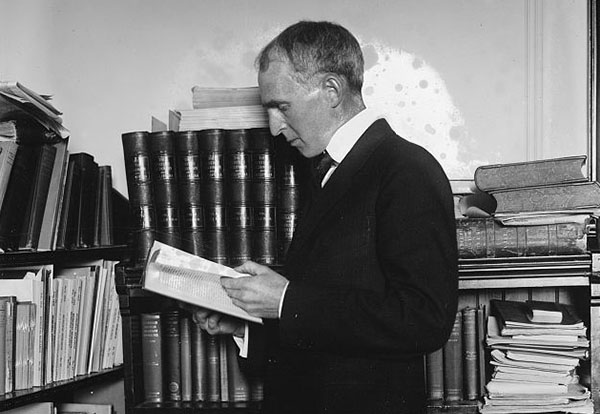
Historians have interpreted the American Revolution through the lens of their own times.
History is never written in a vacuum. Historical narratives are always a product of their own time and historical circumstances. The history of the American Revolution, the United State’s founding narrative, is no exception. It has been viewed in different ways by succeeding generations of historians, and they have seen it through the prism of their own times.
George Bancroft (1800-1891), the first scholar to attempt a comprehensive survey of the colonies’ history up through the Revolution, was a wealthy New England Brahmin who had studied at Harvard and several German universities.
Despite his pedigree, he was caught up in the democratic spirit of the Jacksonian Age, and his History of the United States, the first volumes of which were published in 1834, extolled the common people to the extent that he saw the divine will working through their actions in the Revolution. His opus, which eventually grew to ten volumes, depicted all the rebelling colonists as being subsumed into one great whole unified by a Protestant, republican ethos.
Charles Beard Brings Class into the American Revolution
A later generation of historians who became prominent in the 1910s-1920s, the “Progressives,” looked at American history in a radically altered country from the one that had given rise to Bancroft’s buoyant interpretation. By the turn of century, the U.S. was a country fraught with industrial and rural strife. The dramatic expansion of the railroads in the last third of the nineteenth century had forced farmers all over the country to compete in the national market, and many lost their farms.
They swarmed into the cities looking for work where they were joined in the 1890s by massive waves of immigrants from southern and eastern Europe. Colossal corporations called “trusts” swallowed up smaller businesses, consolidating entire industries into the hands of a few. The laissez-faire policies of the federal government ignored the squalid working and living conditions of the poor in the cities and the plight of the farmers.
Charles Beard, a young Columbia professor who had been involved in the Progressive movement, an effort to ameliorate the problems spawned by rapid industrialization, applied the movement’s focus on economics to American history, and specifically to the founding fathers.
His book, An Economic Interpretation of the Constitution (1913), depicted the founders as elitist statesmen seeking to consolidate their own economic preeminence and the Constitution as a conservative counter revolution designed to reign in the “lower sorts” of people, who had exercised their political will in ways disturbing to their betters during the Revolution and the years following it.
Unlike Bancroft, who saw the people as one, Beard’s analysis suggested that class divisions had existed from the start, and that the major players were motivated not by lofty political theories but rather by their own economic interests.
Consensus Historians Attack Beard
Beard’s work was strongly critiqued in the mid-1950s by a group of scholars who would become known as “Consensus” historians. They pointed out, among other problems, that Beard’s interpretation was inspired by the political philosophy of Progressivism.
The Consensus historians were, of course, products of their time as much as the Progressives. The U.S. was enjoying an unprecedented post-war boom, and the Cold War was the dominant political reality of the day. The vibrant economy meant that there was a minimum of labor and social strife, and the fear of communism tended to overshadow problematic issues such as race relations. Not surprisingly, when Consensus historians looked at the American Revolution, they saw the colonists as a body of people undivided by class who were acting to preserve their natural rights.
The New Left
In the 1960s, a new group of historians would advance interpretations that reflected the generational, racial and class conflicts of their own era. Gary Nash examined the rhetoric of ordinary people as well as tax lists, poor relief rolls, and probate records, and found evidence of a growing class divide in colonial cities in the years leading up to the Revolution. “By the early 1770s, the top 5 percent of Boston’s taxpayers controlled 49 percent of the taxable assets of the community, whereas they held only 30 percent in 1687.”
Nash presented similar figures for New York and Philadelphia. He and other “New Left” historians argued that the urban protests in the cities before and during the Revolution were directed not just at the British, but also at the growing colonial elite.
“Neo-Whig” historians Gordon Wood and Bernard Bailyn countered Progressive and New Left historians with arguments that there was little evidence of class solidarity amongst the colonists.
Wood argued that they were so focused on the people above and below them in the old world social hierarchy that they were scarcely aware of those on their own level. Bailyn delineated the maddening complexity of defining social classes in the colonies.
In dismissing obvious economic and political motives, Wood and Bailyn have made a case for the primacy of ideas in the Revolution, and they have posited a rich, complex and variegated republicanism, which had cross class appeal, as the primary catalyst of the Revolution.
References:
- Charles Beard. An Economic Intererpretation of the Constitution (New York: The Free Press, 1913, 1935, 1986)
- Richard Hofstadter. The Progressive Historians (New York: Alfred A. Knopf, 1968)
- Gary Nash. Class and Society in Early America (Englewood Cliffs: Prentice-Hall, Inc. 1970)
- Gordon Wood. The Radicalism of the American Revolution (New York: Alfred A. Knopf, 1992)
- Alfred Young. Beyond the The American Revolution: Explorations in the History of American Radicalism (Decalb: Northern Illinois University Press, 1993)







